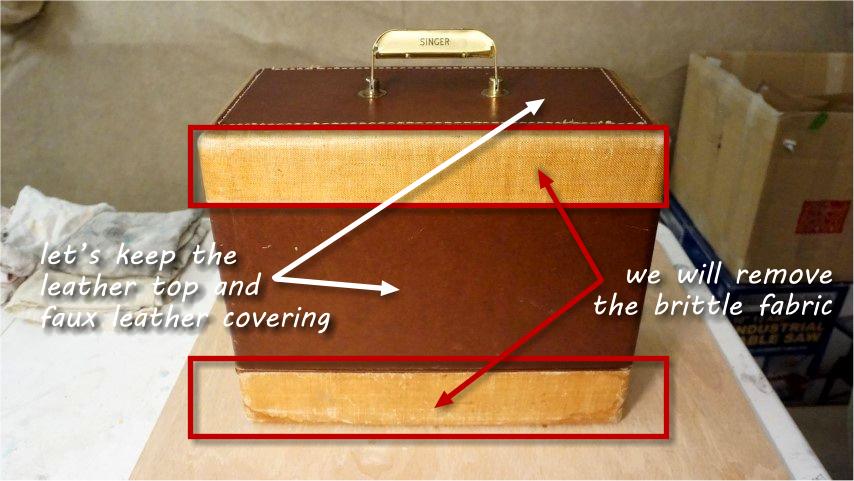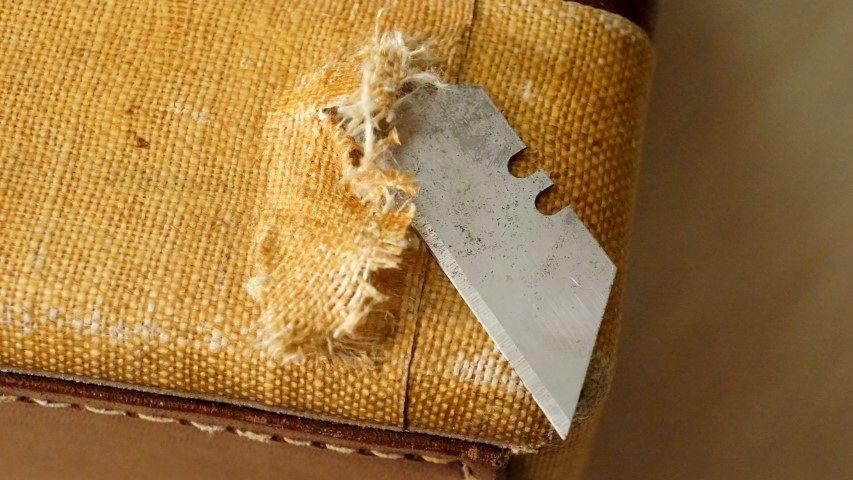Let's continue our project to restore a Singer 99 case (or any other vintage sewing case of this type) by removing the fabric. Sometimes the fabric is stubborn; sometimes it isn't. Either way, removal is accomplished with a little effort and determination.
The Four Parts of this Tutorial
- Part 1: The Handle
- Part 2: Removing the Fabric
- Part 3: Sanding & Wood Pair
- Part 4: Finishing
In Part 1: The Handle, we discussed refurbishing the handle on a Singer 99 carrying case. If refurbishing an entire case, it might make sense to do the handle last, but it's a matter of preference.
Now we'll continue by removing the brittle old fabric. This will expose the wood underneath to be refinished. With this particular case, I intend to keep the leather pad on top and the faux leather that covers most of the lid.
Watch this short video to demonstrate the technique I use, then I'll discuss the steps:
If this is your first time doing this, there may come a point at which you wish you had not started removing the fabric - it can be stubborn and you'll have reached the "point of no return." Believe me, I've been there! Depending on the life your case has already lived (dry conditions, humidity, liquid spills, tender care, abuse, etc.) the fabric may pull away easily, or it may frustrate you. Just hang in there, keep working little by little, and you will get through it.
Caution! My method relies on the use of a razor blade. If you use a blade please never pull it or push it toward your own flesh. If the blade slips you may push/pull it directly into your own arm, wrist, hand, fingers, or body. You will see me use a box cutter blade with no handle. This allows me the control and precise pressure that works well for me, but you may wish to use a hobby knife or a razor-like blade with a handle.
Often these cases will have torn areas where you can immediately grab the fabric and start pulling it away from the case. When I cannot get a grip on the fabric to begin, I use my blade at an angle to cut into the fabric, always taking care to not dig into the wood underneath excessively - minor nicks won't be a problem when we sand the case later.
When attempting to pull away the fabric, you can try pliers or vice-grips to help. As you pull the fabric away, take care near the faux leather if you wish to keep it in place as I intend with this case. The stitching which holds the leather in place is typically very strong, allowing you to pull the fabric away without affecting the leather.
I use my blade to carefully trim the fabric all the way up to the leather pad on top of the case. This requires patience, and please be very careful with your blade.
That fuzzy rough surface is the glue and a little of the fabric backing still adhered to the case. Some have suggested using moisture and/or stripping agents to remove the fabric, but I prefer to work dry. These cases are decades old and I don't want to introduce moisture to them unnecessarily. I find that sanding away the remaining glue and fabric remnants works perfectly well, and the wood has to be sanded anyway to prepare it for refinishing.
The bottom portion of the case also has some faux leather trim, but it will work best to remove all the old fabric and faux leather contact paper covering the bottom.
I remove the small latch that helps keep the sewing machine in place normally. I've encountered many cases that are missing this latch.
I use my blade to encourage the fabric when necessary, and to trim closely around the latches. If you have the knowledge and resources, you could remove the latches by grinding away the pins. We sometimes replace all hardware on our refurbished cases. However, this particular case has decent latches that will clean up nicely and we can pretty easily work with them in place.
It turned out that after some thought, our client decided she would prefer to remove the faux leather wrapping around the sides of the case. We will remove it as we resume our project in Part 3.
The Four Parts of this Tutorial
- Part 1: The Handle
- Part 2: Removing the Fabric
- Part 3: Sanding & Wood Pair
- Part 4: Finishing









5 comments:
Thanks for doing these tutorials. I have several of these cases and they are my 2019 projects...as are the machines!
Our please, Jan - thank you for reading :)
I am having trouble getting my 99K out of this very case. Any pointers? And, may I ask, where do you pick up new latches?
Thanks!
Katherine
Katherine - please use our contact form to email us at Still Stitching and we'll correspond with you on this issue. Should be easy. And for the latches, please try David Werther at https://www.quilters-connection.com.
What if you decide to leave the leather on the sides on in addition to the top leather? Can you just sand the exposed wood above the leather and on the base and stain it as you've shown with the leather wrap still on? If the inside paper is fragile, is it worth taking off, or just leave on? Thank you.
Post a Comment